LSC UoS BA - PepsiCo Case Study: Organisational Theory and Practice
VerifiedAdded on 2023/06/10
|13
|3873
|493
Case Study
AI Summary
This case study provides an in-depth analysis of PepsiCo's organisational structure and culture, examining their impact on the company's management and employee motivation. It explores various organisational structures, including hierarchical, functional, matrix, and team-based structures, and discusses Charles Handy's model of organisational culture, which includes role, task, power, and personal cultures. The analysis highlights how PepsiCo combines role and task cultures to adapt to changing business conditions and leadership requirements, fostering a culture of performance with purpose, real-world leadership, and collaboration. The study further investigates how PepsiCo's organisational structure supports its global expansion and leadership strategies, concluding with recommendations for improvements to enhance the company's overall performance. Desklib provides access to similar case studies and study resources for students.
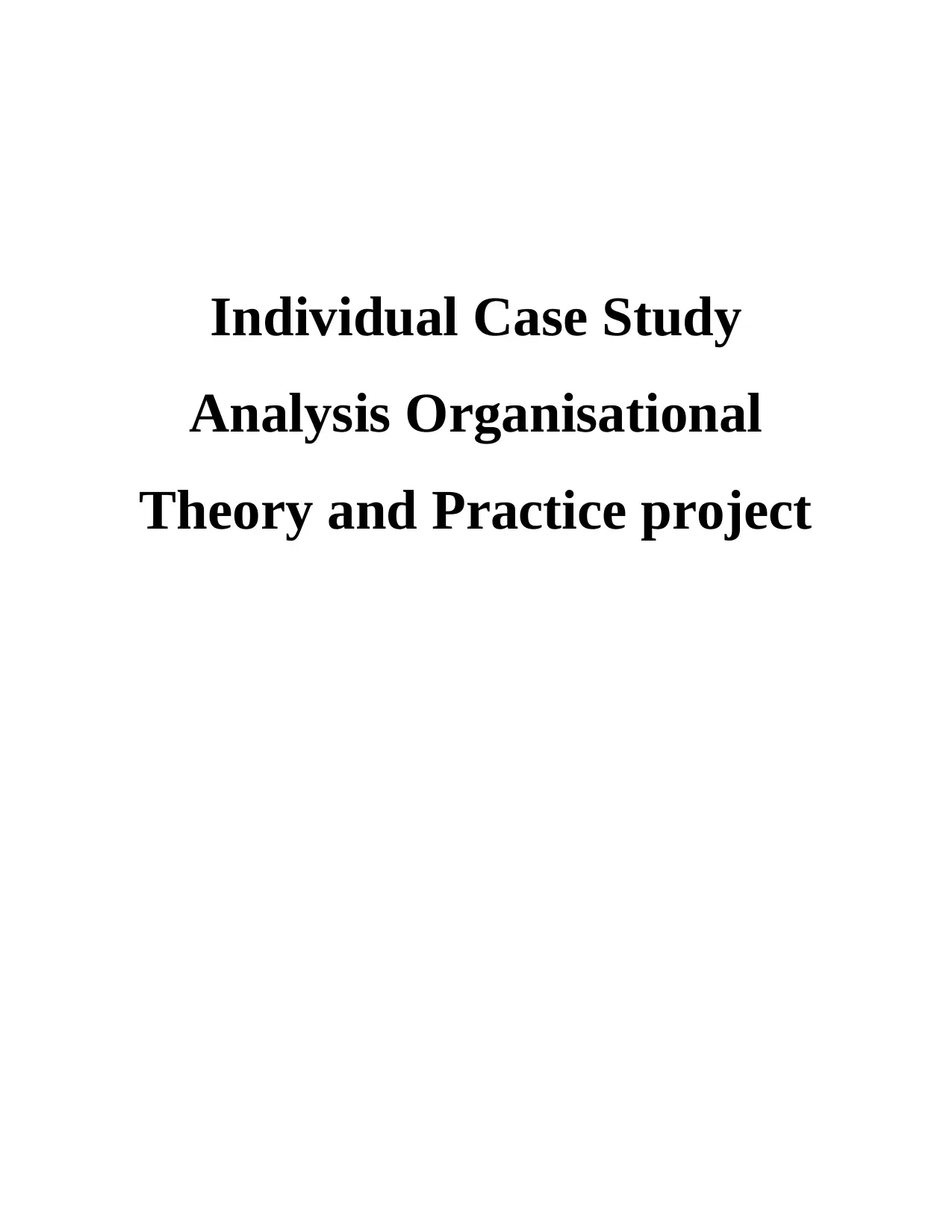
Individual Case Study
Analysis Organisational
Theory and Practice project
Analysis Organisational
Theory and Practice project
Paraphrase This Document
Need a fresh take? Get an instant paraphrase of this document with our AI Paraphraser
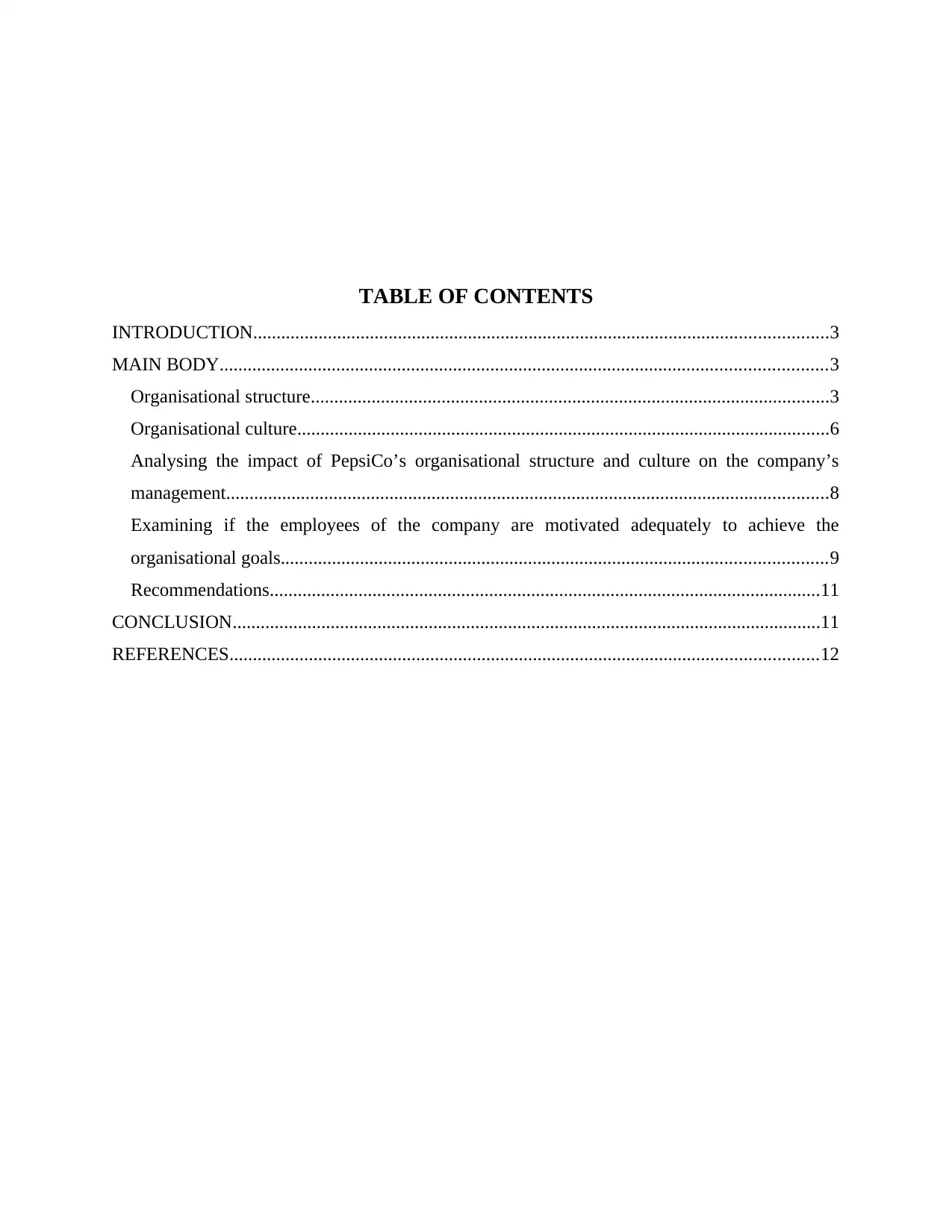
TABLE OF CONTENTS
INTRODUCTION...........................................................................................................................3
MAIN BODY..................................................................................................................................3
Organisational structure...............................................................................................................3
Organisational culture..................................................................................................................6
Analysing the impact of PepsiCo’s organisational structure and culture on the company’s
management.................................................................................................................................8
Examining if the employees of the company are motivated adequately to achieve the
organisational goals.....................................................................................................................9
Recommendations......................................................................................................................11
CONCLUSION..............................................................................................................................11
REFERENCES..............................................................................................................................12
INTRODUCTION...........................................................................................................................3
MAIN BODY..................................................................................................................................3
Organisational structure...............................................................................................................3
Organisational culture..................................................................................................................6
Analysing the impact of PepsiCo’s organisational structure and culture on the company’s
management.................................................................................................................................8
Examining if the employees of the company are motivated adequately to achieve the
organisational goals.....................................................................................................................9
Recommendations......................................................................................................................11
CONCLUSION..............................................................................................................................11
REFERENCES..............................................................................................................................12
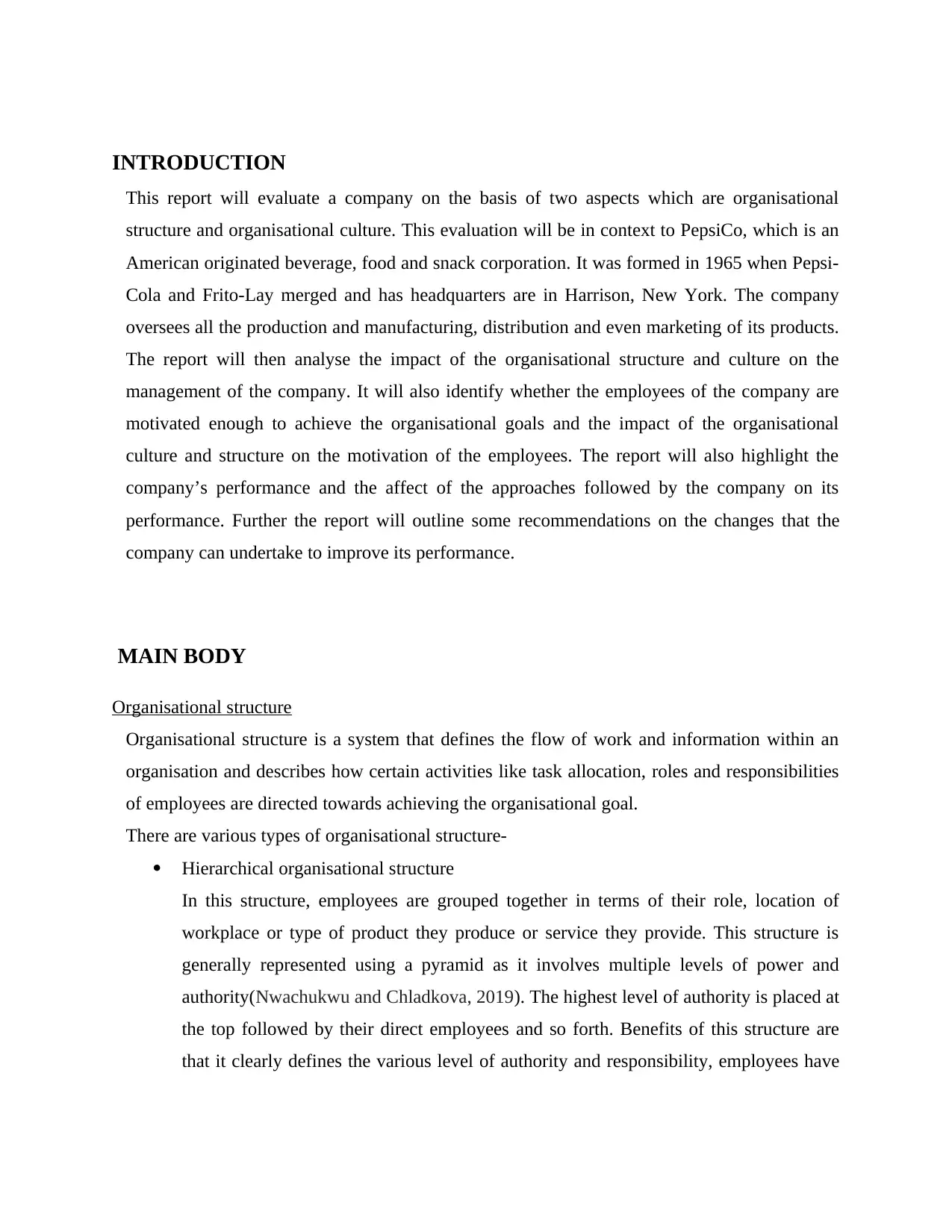
INTRODUCTION
This report will evaluate a company on the basis of two aspects which are organisational
structure and organisational culture. This evaluation will be in context to PepsiCo, which is an
American originated beverage, food and snack corporation. It was formed in 1965 when Pepsi-
Cola and Frito-Lay merged and has headquarters are in Harrison, New York. The company
oversees all the production and manufacturing, distribution and even marketing of its products.
The report will then analyse the impact of the organisational structure and culture on the
management of the company. It will also identify whether the employees of the company are
motivated enough to achieve the organisational goals and the impact of the organisational
culture and structure on the motivation of the employees. The report will also highlight the
company’s performance and the affect of the approaches followed by the company on its
performance. Further the report will outline some recommendations on the changes that the
company can undertake to improve its performance.
MAIN BODY
Organisational structure
Organisational structure is a system that defines the flow of work and information within an
organisation and describes how certain activities like task allocation, roles and responsibilities
of employees are directed towards achieving the organisational goal.
There are various types of organisational structure-
Hierarchical organisational structure
In this structure, employees are grouped together in terms of their role, location of
workplace or type of product they produce or service they provide. This structure is
generally represented using a pyramid as it involves multiple levels of power and
authority(Nwachukwu and Chladkova, 2019). The highest level of authority is placed at
the top followed by their direct employees and so forth. Benefits of this structure are
that it clearly defines the various level of authority and responsibility, employees have
This report will evaluate a company on the basis of two aspects which are organisational
structure and organisational culture. This evaluation will be in context to PepsiCo, which is an
American originated beverage, food and snack corporation. It was formed in 1965 when Pepsi-
Cola and Frito-Lay merged and has headquarters are in Harrison, New York. The company
oversees all the production and manufacturing, distribution and even marketing of its products.
The report will then analyse the impact of the organisational structure and culture on the
management of the company. It will also identify whether the employees of the company are
motivated enough to achieve the organisational goals and the impact of the organisational
culture and structure on the motivation of the employees. The report will also highlight the
company’s performance and the affect of the approaches followed by the company on its
performance. Further the report will outline some recommendations on the changes that the
company can undertake to improve its performance.
MAIN BODY
Organisational structure
Organisational structure is a system that defines the flow of work and information within an
organisation and describes how certain activities like task allocation, roles and responsibilities
of employees are directed towards achieving the organisational goal.
There are various types of organisational structure-
Hierarchical organisational structure
In this structure, employees are grouped together in terms of their role, location of
workplace or type of product they produce or service they provide. This structure is
generally represented using a pyramid as it involves multiple levels of power and
authority(Nwachukwu and Chladkova, 2019). The highest level of authority is placed at
the top followed by their direct employees and so forth. Benefits of this structure are
that it clearly defines the various level of authority and responsibility, employees have
⊘ This is a preview!⊘
Do you want full access?
Subscribe today to unlock all pages.

Trusted by 1+ million students worldwide
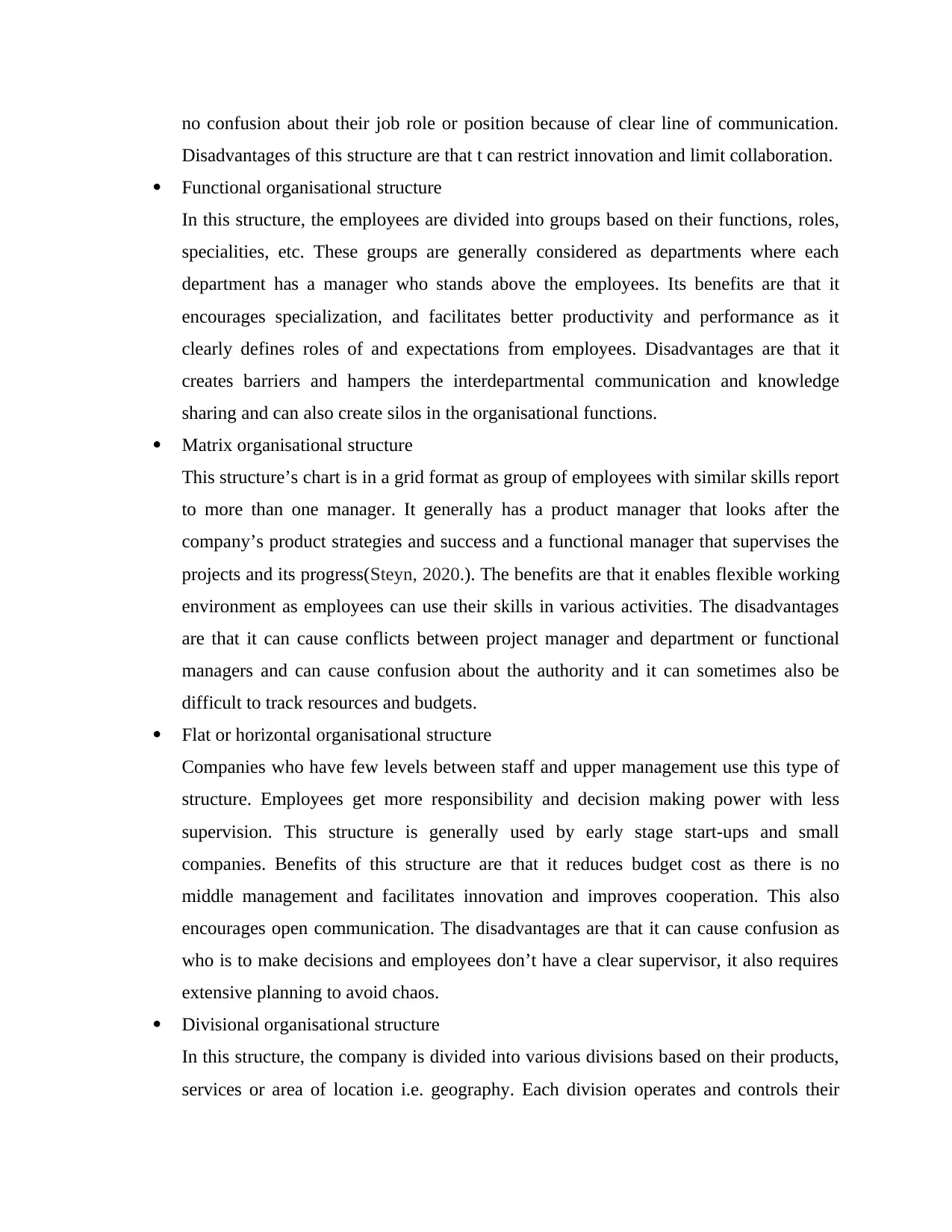
no confusion about their job role or position because of clear line of communication.
Disadvantages of this structure are that t can restrict innovation and limit collaboration.
Functional organisational structure
In this structure, the employees are divided into groups based on their functions, roles,
specialities, etc. These groups are generally considered as departments where each
department has a manager who stands above the employees. Its benefits are that it
encourages specialization, and facilitates better productivity and performance as it
clearly defines roles of and expectations from employees. Disadvantages are that it
creates barriers and hampers the interdepartmental communication and knowledge
sharing and can also create silos in the organisational functions.
Matrix organisational structure
This structure’s chart is in a grid format as group of employees with similar skills report
to more than one manager. It generally has a product manager that looks after the
company’s product strategies and success and a functional manager that supervises the
projects and its progress(Steyn, 2020.). The benefits are that it enables flexible working
environment as employees can use their skills in various activities. The disadvantages
are that it can cause conflicts between project manager and department or functional
managers and can cause confusion about the authority and it can sometimes also be
difficult to track resources and budgets.
Flat or horizontal organisational structure
Companies who have few levels between staff and upper management use this type of
structure. Employees get more responsibility and decision making power with less
supervision. This structure is generally used by early stage start-ups and small
companies. Benefits of this structure are that it reduces budget cost as there is no
middle management and facilitates innovation and improves cooperation. This also
encourages open communication. The disadvantages are that it can cause confusion as
who is to make decisions and employees don’t have a clear supervisor, it also requires
extensive planning to avoid chaos.
Divisional organisational structure
In this structure, the company is divided into various divisions based on their products,
services or area of location i.e. geography. Each division operates and controls their
Disadvantages of this structure are that t can restrict innovation and limit collaboration.
Functional organisational structure
In this structure, the employees are divided into groups based on their functions, roles,
specialities, etc. These groups are generally considered as departments where each
department has a manager who stands above the employees. Its benefits are that it
encourages specialization, and facilitates better productivity and performance as it
clearly defines roles of and expectations from employees. Disadvantages are that it
creates barriers and hampers the interdepartmental communication and knowledge
sharing and can also create silos in the organisational functions.
Matrix organisational structure
This structure’s chart is in a grid format as group of employees with similar skills report
to more than one manager. It generally has a product manager that looks after the
company’s product strategies and success and a functional manager that supervises the
projects and its progress(Steyn, 2020.). The benefits are that it enables flexible working
environment as employees can use their skills in various activities. The disadvantages
are that it can cause conflicts between project manager and department or functional
managers and can cause confusion about the authority and it can sometimes also be
difficult to track resources and budgets.
Flat or horizontal organisational structure
Companies who have few levels between staff and upper management use this type of
structure. Employees get more responsibility and decision making power with less
supervision. This structure is generally used by early stage start-ups and small
companies. Benefits of this structure are that it reduces budget cost as there is no
middle management and facilitates innovation and improves cooperation. This also
encourages open communication. The disadvantages are that it can cause confusion as
who is to make decisions and employees don’t have a clear supervisor, it also requires
extensive planning to avoid chaos.
Divisional organisational structure
In this structure, the company is divided into various divisions based on their products,
services or area of location i.e. geography. Each division operates and controls their
Paraphrase This Document
Need a fresh take? Get an instant paraphrase of this document with our AI Paraphraser
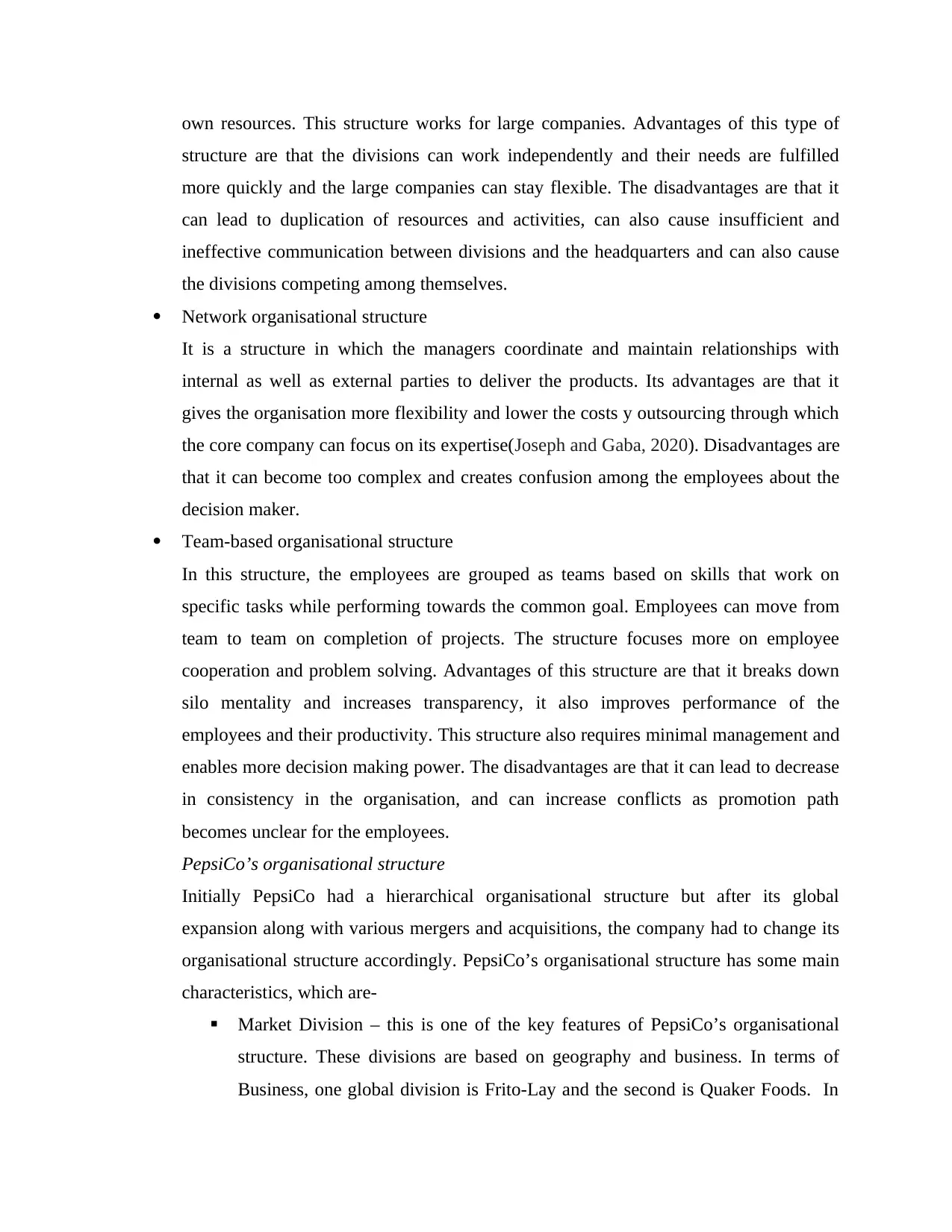
own resources. This structure works for large companies. Advantages of this type of
structure are that the divisions can work independently and their needs are fulfilled
more quickly and the large companies can stay flexible. The disadvantages are that it
can lead to duplication of resources and activities, can also cause insufficient and
ineffective communication between divisions and the headquarters and can also cause
the divisions competing among themselves.
Network organisational structure
It is a structure in which the managers coordinate and maintain relationships with
internal as well as external parties to deliver the products. Its advantages are that it
gives the organisation more flexibility and lower the costs y outsourcing through which
the core company can focus on its expertise(Joseph and Gaba, 2020). Disadvantages are
that it can become too complex and creates confusion among the employees about the
decision maker.
Team-based organisational structure
In this structure, the employees are grouped as teams based on skills that work on
specific tasks while performing towards the common goal. Employees can move from
team to team on completion of projects. The structure focuses more on employee
cooperation and problem solving. Advantages of this structure are that it breaks down
silo mentality and increases transparency, it also improves performance of the
employees and their productivity. This structure also requires minimal management and
enables more decision making power. The disadvantages are that it can lead to decrease
in consistency in the organisation, and can increase conflicts as promotion path
becomes unclear for the employees.
PepsiCo’s organisational structure
Initially PepsiCo had a hierarchical organisational structure but after its global
expansion along with various mergers and acquisitions, the company had to change its
organisational structure accordingly. PepsiCo’s organisational structure has some main
characteristics, which are-
Market Division – this is one of the key features of PepsiCo’s organisational
structure. These divisions are based on geography and business. In terms of
Business, one global division is Frito-Lay and the second is Quaker Foods. In
structure are that the divisions can work independently and their needs are fulfilled
more quickly and the large companies can stay flexible. The disadvantages are that it
can lead to duplication of resources and activities, can also cause insufficient and
ineffective communication between divisions and the headquarters and can also cause
the divisions competing among themselves.
Network organisational structure
It is a structure in which the managers coordinate and maintain relationships with
internal as well as external parties to deliver the products. Its advantages are that it
gives the organisation more flexibility and lower the costs y outsourcing through which
the core company can focus on its expertise(Joseph and Gaba, 2020). Disadvantages are
that it can become too complex and creates confusion among the employees about the
decision maker.
Team-based organisational structure
In this structure, the employees are grouped as teams based on skills that work on
specific tasks while performing towards the common goal. Employees can move from
team to team on completion of projects. The structure focuses more on employee
cooperation and problem solving. Advantages of this structure are that it breaks down
silo mentality and increases transparency, it also improves performance of the
employees and their productivity. This structure also requires minimal management and
enables more decision making power. The disadvantages are that it can lead to decrease
in consistency in the organisation, and can increase conflicts as promotion path
becomes unclear for the employees.
PepsiCo’s organisational structure
Initially PepsiCo had a hierarchical organisational structure but after its global
expansion along with various mergers and acquisitions, the company had to change its
organisational structure accordingly. PepsiCo’s organisational structure has some main
characteristics, which are-
Market Division – this is one of the key features of PepsiCo’s organisational
structure. These divisions are based on geography and business. In terms of
Business, one global division is Frito-Lay and the second is Quaker Foods. In
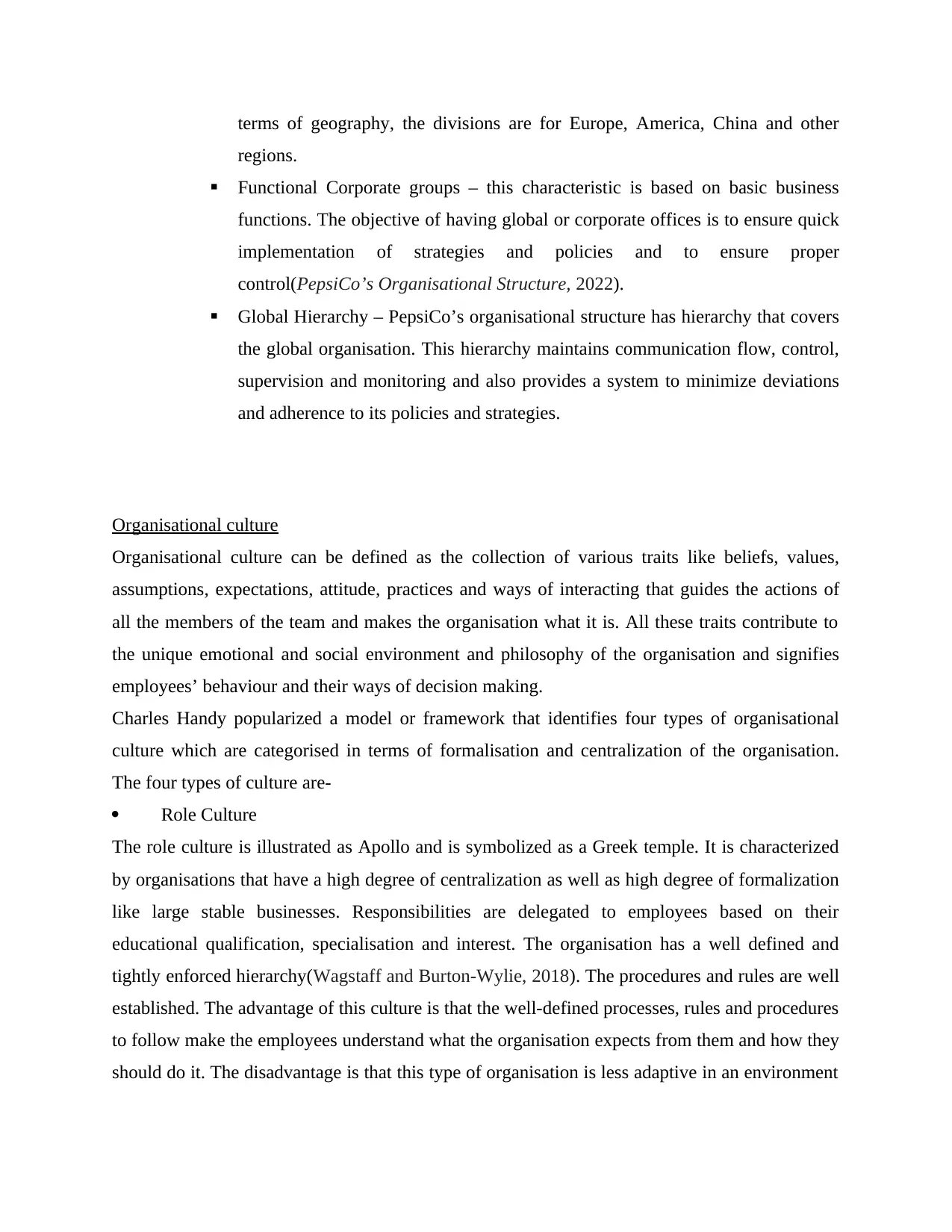
terms of geography, the divisions are for Europe, America, China and other
regions.
Functional Corporate groups – this characteristic is based on basic business
functions. The objective of having global or corporate offices is to ensure quick
implementation of strategies and policies and to ensure proper
control(PepsiCo’s Organisational Structure, 2022).
Global Hierarchy – PepsiCo’s organisational structure has hierarchy that covers
the global organisation. This hierarchy maintains communication flow, control,
supervision and monitoring and also provides a system to minimize deviations
and adherence to its policies and strategies.
Organisational culture
Organisational culture can be defined as the collection of various traits like beliefs, values,
assumptions, expectations, attitude, practices and ways of interacting that guides the actions of
all the members of the team and makes the organisation what it is. All these traits contribute to
the unique emotional and social environment and philosophy of the organisation and signifies
employees’ behaviour and their ways of decision making.
Charles Handy popularized a model or framework that identifies four types of organisational
culture which are categorised in terms of formalisation and centralization of the organisation.
The four types of culture are-
Role Culture
The role culture is illustrated as Apollo and is symbolized as a Greek temple. It is characterized
by organisations that have a high degree of centralization as well as high degree of formalization
like large stable businesses. Responsibilities are delegated to employees based on their
educational qualification, specialisation and interest. The organisation has a well defined and
tightly enforced hierarchy(Wagstaff and Burton-Wylie, 2018). The procedures and rules are well
established. The advantage of this culture is that the well-defined processes, rules and procedures
to follow make the employees understand what the organisation expects from them and how they
should do it. The disadvantage is that this type of organisation is less adaptive in an environment
regions.
Functional Corporate groups – this characteristic is based on basic business
functions. The objective of having global or corporate offices is to ensure quick
implementation of strategies and policies and to ensure proper
control(PepsiCo’s Organisational Structure, 2022).
Global Hierarchy – PepsiCo’s organisational structure has hierarchy that covers
the global organisation. This hierarchy maintains communication flow, control,
supervision and monitoring and also provides a system to minimize deviations
and adherence to its policies and strategies.
Organisational culture
Organisational culture can be defined as the collection of various traits like beliefs, values,
assumptions, expectations, attitude, practices and ways of interacting that guides the actions of
all the members of the team and makes the organisation what it is. All these traits contribute to
the unique emotional and social environment and philosophy of the organisation and signifies
employees’ behaviour and their ways of decision making.
Charles Handy popularized a model or framework that identifies four types of organisational
culture which are categorised in terms of formalisation and centralization of the organisation.
The four types of culture are-
Role Culture
The role culture is illustrated as Apollo and is symbolized as a Greek temple. It is characterized
by organisations that have a high degree of centralization as well as high degree of formalization
like large stable businesses. Responsibilities are delegated to employees based on their
educational qualification, specialisation and interest. The organisation has a well defined and
tightly enforced hierarchy(Wagstaff and Burton-Wylie, 2018). The procedures and rules are well
established. The advantage of this culture is that the well-defined processes, rules and procedures
to follow make the employees understand what the organisation expects from them and how they
should do it. The disadvantage is that this type of organisation is less adaptive in an environment
⊘ This is a preview!⊘
Do you want full access?
Subscribe today to unlock all pages.

Trusted by 1+ million students worldwide
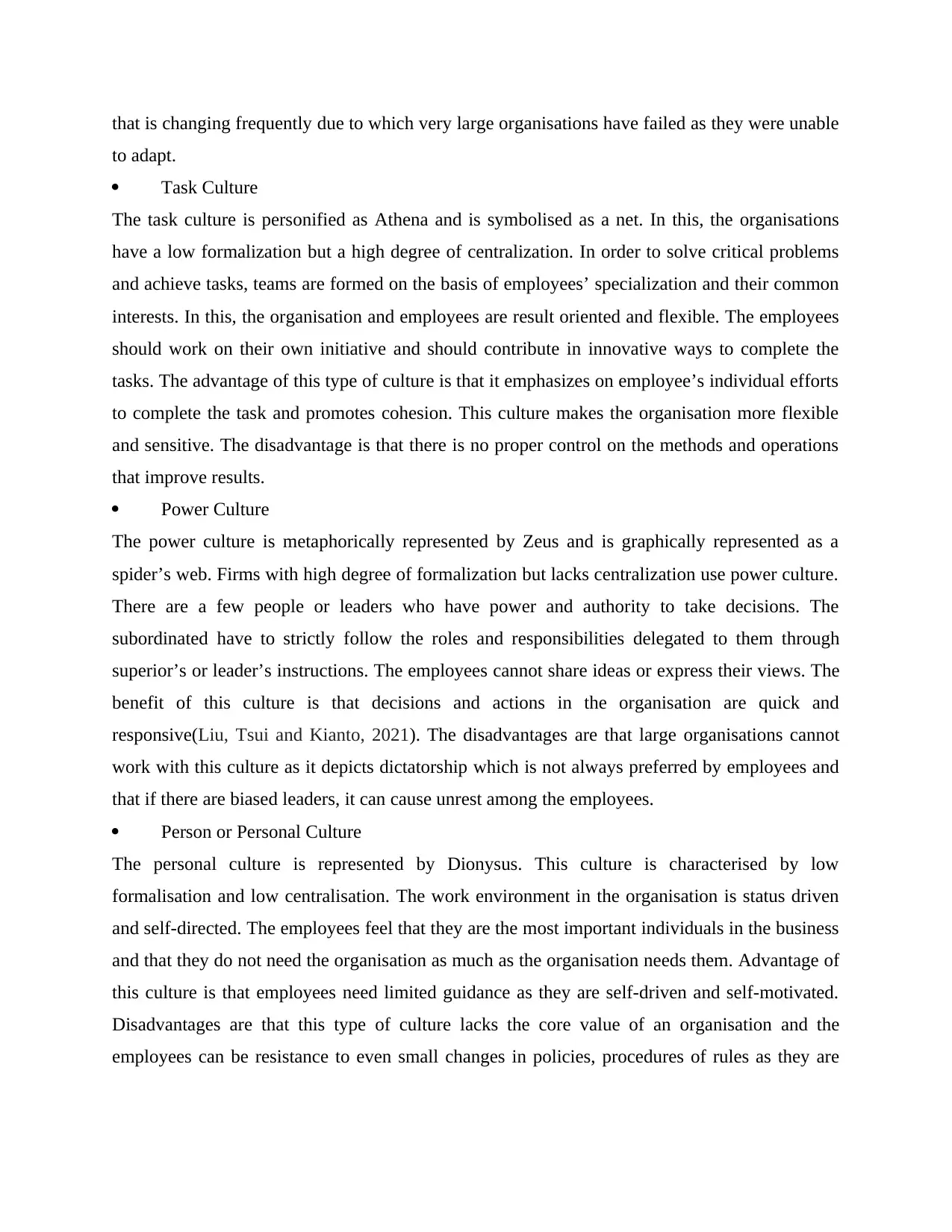
that is changing frequently due to which very large organisations have failed as they were unable
to adapt.
Task Culture
The task culture is personified as Athena and is symbolised as a net. In this, the organisations
have a low formalization but a high degree of centralization. In order to solve critical problems
and achieve tasks, teams are formed on the basis of employees’ specialization and their common
interests. In this, the organisation and employees are result oriented and flexible. The employees
should work on their own initiative and should contribute in innovative ways to complete the
tasks. The advantage of this type of culture is that it emphasizes on employee’s individual efforts
to complete the task and promotes cohesion. This culture makes the organisation more flexible
and sensitive. The disadvantage is that there is no proper control on the methods and operations
that improve results.
Power Culture
The power culture is metaphorically represented by Zeus and is graphically represented as a
spider’s web. Firms with high degree of formalization but lacks centralization use power culture.
There are a few people or leaders who have power and authority to take decisions. The
subordinated have to strictly follow the roles and responsibilities delegated to them through
superior’s or leader’s instructions. The employees cannot share ideas or express their views. The
benefit of this culture is that decisions and actions in the organisation are quick and
responsive(Liu, Tsui and Kianto, 2021). The disadvantages are that large organisations cannot
work with this culture as it depicts dictatorship which is not always preferred by employees and
that if there are biased leaders, it can cause unrest among the employees.
Person or Personal Culture
The personal culture is represented by Dionysus. This culture is characterised by low
formalisation and low centralisation. The work environment in the organisation is status driven
and self-directed. The employees feel that they are the most important individuals in the business
and that they do not need the organisation as much as the organisation needs them. Advantage of
this culture is that employees need limited guidance as they are self-driven and self-motivated.
Disadvantages are that this type of culture lacks the core value of an organisation and the
employees can be resistance to even small changes in policies, procedures of rules as they are
to adapt.
Task Culture
The task culture is personified as Athena and is symbolised as a net. In this, the organisations
have a low formalization but a high degree of centralization. In order to solve critical problems
and achieve tasks, teams are formed on the basis of employees’ specialization and their common
interests. In this, the organisation and employees are result oriented and flexible. The employees
should work on their own initiative and should contribute in innovative ways to complete the
tasks. The advantage of this type of culture is that it emphasizes on employee’s individual efforts
to complete the task and promotes cohesion. This culture makes the organisation more flexible
and sensitive. The disadvantage is that there is no proper control on the methods and operations
that improve results.
Power Culture
The power culture is metaphorically represented by Zeus and is graphically represented as a
spider’s web. Firms with high degree of formalization but lacks centralization use power culture.
There are a few people or leaders who have power and authority to take decisions. The
subordinated have to strictly follow the roles and responsibilities delegated to them through
superior’s or leader’s instructions. The employees cannot share ideas or express their views. The
benefit of this culture is that decisions and actions in the organisation are quick and
responsive(Liu, Tsui and Kianto, 2021). The disadvantages are that large organisations cannot
work with this culture as it depicts dictatorship which is not always preferred by employees and
that if there are biased leaders, it can cause unrest among the employees.
Person or Personal Culture
The personal culture is represented by Dionysus. This culture is characterised by low
formalisation and low centralisation. The work environment in the organisation is status driven
and self-directed. The employees feel that they are the most important individuals in the business
and that they do not need the organisation as much as the organisation needs them. Advantage of
this culture is that employees need limited guidance as they are self-driven and self-motivated.
Disadvantages are that this type of culture lacks the core value of an organisation and the
employees can be resistance to even small changes in policies, procedures of rules as they are
Paraphrase This Document
Need a fresh take? Get an instant paraphrase of this document with our AI Paraphraser
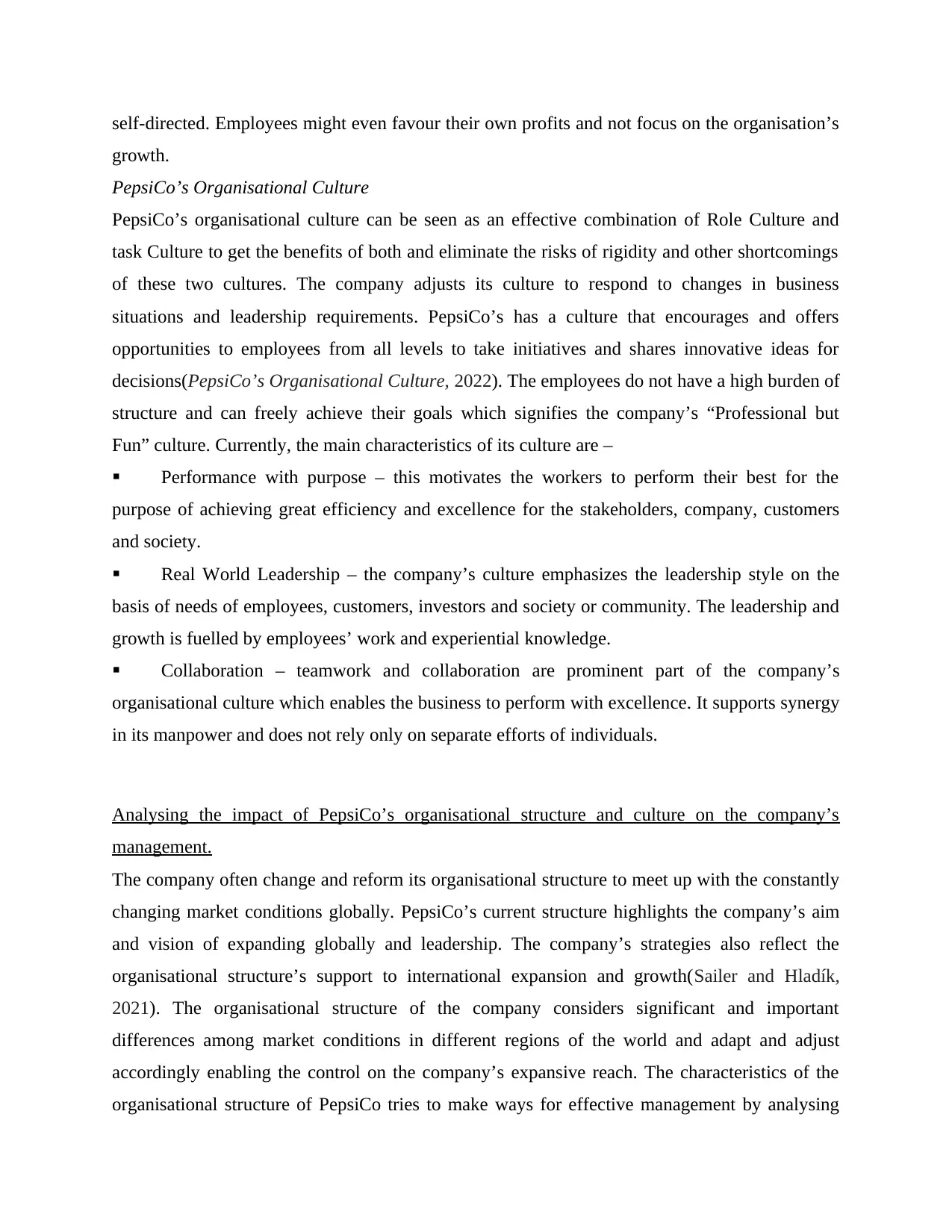
self-directed. Employees might even favour their own profits and not focus on the organisation’s
growth.
PepsiCo’s Organisational Culture
PepsiCo’s organisational culture can be seen as an effective combination of Role Culture and
task Culture to get the benefits of both and eliminate the risks of rigidity and other shortcomings
of these two cultures. The company adjusts its culture to respond to changes in business
situations and leadership requirements. PepsiCo’s has a culture that encourages and offers
opportunities to employees from all levels to take initiatives and shares innovative ideas for
decisions(PepsiCo’s Organisational Culture, 2022). The employees do not have a high burden of
structure and can freely achieve their goals which signifies the company’s “Professional but
Fun” culture. Currently, the main characteristics of its culture are –
Performance with purpose – this motivates the workers to perform their best for the
purpose of achieving great efficiency and excellence for the stakeholders, company, customers
and society.
Real World Leadership – the company’s culture emphasizes the leadership style on the
basis of needs of employees, customers, investors and society or community. The leadership and
growth is fuelled by employees’ work and experiential knowledge.
Collaboration – teamwork and collaboration are prominent part of the company’s
organisational culture which enables the business to perform with excellence. It supports synergy
in its manpower and does not rely only on separate efforts of individuals.
Analysing the impact of PepsiCo’s organisational structure and culture on the company’s
management.
The company often change and reform its organisational structure to meet up with the constantly
changing market conditions globally. PepsiCo’s current structure highlights the company’s aim
and vision of expanding globally and leadership. The company’s strategies also reflect the
organisational structure’s support to international expansion and growth(Sailer and Hladík,
2021). The organisational structure of the company considers significant and important
differences among market conditions in different regions of the world and adapt and adjust
accordingly enabling the control on the company’s expansive reach. The characteristics of the
organisational structure of PepsiCo tries to make ways for effective management by analysing
growth.
PepsiCo’s Organisational Culture
PepsiCo’s organisational culture can be seen as an effective combination of Role Culture and
task Culture to get the benefits of both and eliminate the risks of rigidity and other shortcomings
of these two cultures. The company adjusts its culture to respond to changes in business
situations and leadership requirements. PepsiCo’s has a culture that encourages and offers
opportunities to employees from all levels to take initiatives and shares innovative ideas for
decisions(PepsiCo’s Organisational Culture, 2022). The employees do not have a high burden of
structure and can freely achieve their goals which signifies the company’s “Professional but
Fun” culture. Currently, the main characteristics of its culture are –
Performance with purpose – this motivates the workers to perform their best for the
purpose of achieving great efficiency and excellence for the stakeholders, company, customers
and society.
Real World Leadership – the company’s culture emphasizes the leadership style on the
basis of needs of employees, customers, investors and society or community. The leadership and
growth is fuelled by employees’ work and experiential knowledge.
Collaboration – teamwork and collaboration are prominent part of the company’s
organisational culture which enables the business to perform with excellence. It supports synergy
in its manpower and does not rely only on separate efforts of individuals.
Analysing the impact of PepsiCo’s organisational structure and culture on the company’s
management.
The company often change and reform its organisational structure to meet up with the constantly
changing market conditions globally. PepsiCo’s current structure highlights the company’s aim
and vision of expanding globally and leadership. The company’s strategies also reflect the
organisational structure’s support to international expansion and growth(Sailer and Hladík,
2021). The organisational structure of the company considers significant and important
differences among market conditions in different regions of the world and adapt and adjust
accordingly enabling the control on the company’s expansive reach. The characteristics of the
organisational structure of PepsiCo tries to make ways for effective management by analysing
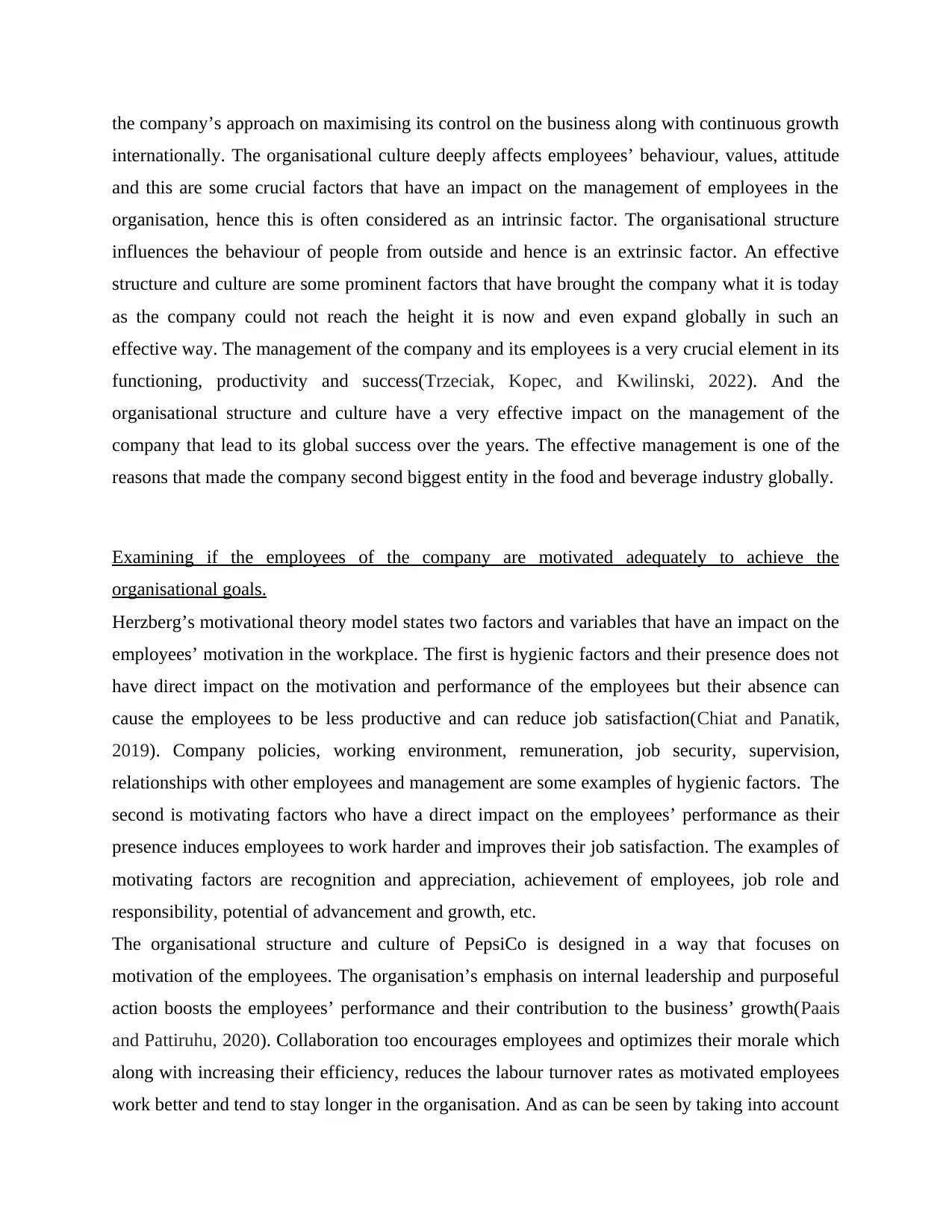
the company’s approach on maximising its control on the business along with continuous growth
internationally. The organisational culture deeply affects employees’ behaviour, values, attitude
and this are some crucial factors that have an impact on the management of employees in the
organisation, hence this is often considered as an intrinsic factor. The organisational structure
influences the behaviour of people from outside and hence is an extrinsic factor. An effective
structure and culture are some prominent factors that have brought the company what it is today
as the company could not reach the height it is now and even expand globally in such an
effective way. The management of the company and its employees is a very crucial element in its
functioning, productivity and success(Trzeciak, Kopec, and Kwilinski, 2022). And the
organisational structure and culture have a very effective impact on the management of the
company that lead to its global success over the years. The effective management is one of the
reasons that made the company second biggest entity in the food and beverage industry globally.
Examining if the employees of the company are motivated adequately to achieve the
organisational goals.
Herzberg’s motivational theory model states two factors and variables that have an impact on the
employees’ motivation in the workplace. The first is hygienic factors and their presence does not
have direct impact on the motivation and performance of the employees but their absence can
cause the employees to be less productive and can reduce job satisfaction(Chiat and Panatik,
2019). Company policies, working environment, remuneration, job security, supervision,
relationships with other employees and management are some examples of hygienic factors. The
second is motivating factors who have a direct impact on the employees’ performance as their
presence induces employees to work harder and improves their job satisfaction. The examples of
motivating factors are recognition and appreciation, achievement of employees, job role and
responsibility, potential of advancement and growth, etc.
The organisational structure and culture of PepsiCo is designed in a way that focuses on
motivation of the employees. The organisation’s emphasis on internal leadership and purposeful
action boosts the employees’ performance and their contribution to the business’ growth(Paais
and Pattiruhu, 2020). Collaboration too encourages employees and optimizes their morale which
along with increasing their efficiency, reduces the labour turnover rates as motivated employees
work better and tend to stay longer in the organisation. And as can be seen by taking into account
internationally. The organisational culture deeply affects employees’ behaviour, values, attitude
and this are some crucial factors that have an impact on the management of employees in the
organisation, hence this is often considered as an intrinsic factor. The organisational structure
influences the behaviour of people from outside and hence is an extrinsic factor. An effective
structure and culture are some prominent factors that have brought the company what it is today
as the company could not reach the height it is now and even expand globally in such an
effective way. The management of the company and its employees is a very crucial element in its
functioning, productivity and success(Trzeciak, Kopec, and Kwilinski, 2022). And the
organisational structure and culture have a very effective impact on the management of the
company that lead to its global success over the years. The effective management is one of the
reasons that made the company second biggest entity in the food and beverage industry globally.
Examining if the employees of the company are motivated adequately to achieve the
organisational goals.
Herzberg’s motivational theory model states two factors and variables that have an impact on the
employees’ motivation in the workplace. The first is hygienic factors and their presence does not
have direct impact on the motivation and performance of the employees but their absence can
cause the employees to be less productive and can reduce job satisfaction(Chiat and Panatik,
2019). Company policies, working environment, remuneration, job security, supervision,
relationships with other employees and management are some examples of hygienic factors. The
second is motivating factors who have a direct impact on the employees’ performance as their
presence induces employees to work harder and improves their job satisfaction. The examples of
motivating factors are recognition and appreciation, achievement of employees, job role and
responsibility, potential of advancement and growth, etc.
The organisational structure and culture of PepsiCo is designed in a way that focuses on
motivation of the employees. The organisation’s emphasis on internal leadership and purposeful
action boosts the employees’ performance and their contribution to the business’ growth(Paais
and Pattiruhu, 2020). Collaboration too encourages employees and optimizes their morale which
along with increasing their efficiency, reduces the labour turnover rates as motivated employees
work better and tend to stay longer in the organisation. And as can be seen by taking into account
⊘ This is a preview!⊘
Do you want full access?
Subscribe today to unlock all pages.

Trusted by 1+ million students worldwide
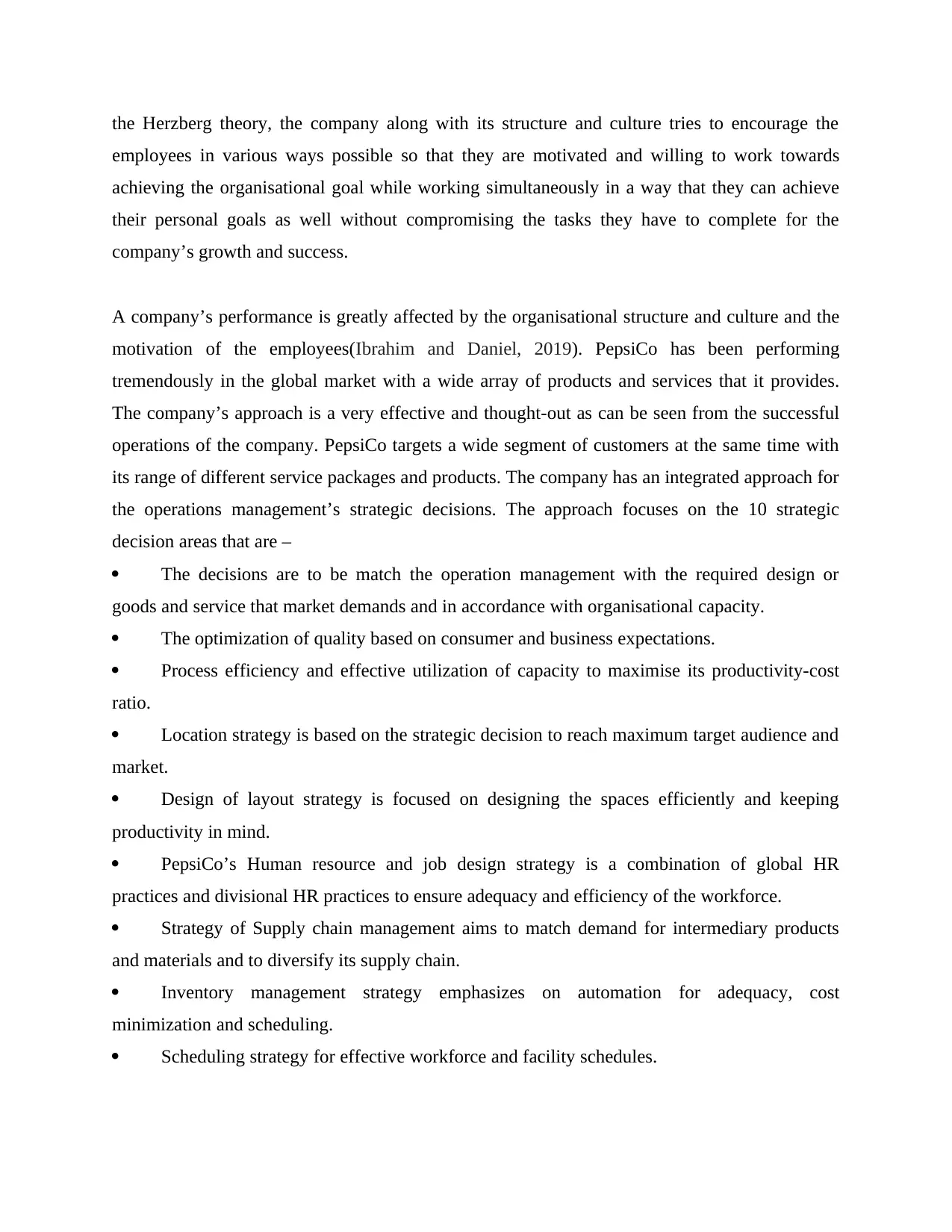
the Herzberg theory, the company along with its structure and culture tries to encourage the
employees in various ways possible so that they are motivated and willing to work towards
achieving the organisational goal while working simultaneously in a way that they can achieve
their personal goals as well without compromising the tasks they have to complete for the
company’s growth and success.
A company’s performance is greatly affected by the organisational structure and culture and the
motivation of the employees(Ibrahim and Daniel, 2019). PepsiCo has been performing
tremendously in the global market with a wide array of products and services that it provides.
The company’s approach is a very effective and thought-out as can be seen from the successful
operations of the company. PepsiCo targets a wide segment of customers at the same time with
its range of different service packages and products. The company has an integrated approach for
the operations management’s strategic decisions. The approach focuses on the 10 strategic
decision areas that are –
The decisions are to be match the operation management with the required design or
goods and service that market demands and in accordance with organisational capacity.
The optimization of quality based on consumer and business expectations.
Process efficiency and effective utilization of capacity to maximise its productivity-cost
ratio.
Location strategy is based on the strategic decision to reach maximum target audience and
market.
Design of layout strategy is focused on designing the spaces efficiently and keeping
productivity in mind.
PepsiCo’s Human resource and job design strategy is a combination of global HR
practices and divisional HR practices to ensure adequacy and efficiency of the workforce.
Strategy of Supply chain management aims to match demand for intermediary products
and materials and to diversify its supply chain.
Inventory management strategy emphasizes on automation for adequacy, cost
minimization and scheduling.
Scheduling strategy for effective workforce and facility schedules.
employees in various ways possible so that they are motivated and willing to work towards
achieving the organisational goal while working simultaneously in a way that they can achieve
their personal goals as well without compromising the tasks they have to complete for the
company’s growth and success.
A company’s performance is greatly affected by the organisational structure and culture and the
motivation of the employees(Ibrahim and Daniel, 2019). PepsiCo has been performing
tremendously in the global market with a wide array of products and services that it provides.
The company’s approach is a very effective and thought-out as can be seen from the successful
operations of the company. PepsiCo targets a wide segment of customers at the same time with
its range of different service packages and products. The company has an integrated approach for
the operations management’s strategic decisions. The approach focuses on the 10 strategic
decision areas that are –
The decisions are to be match the operation management with the required design or
goods and service that market demands and in accordance with organisational capacity.
The optimization of quality based on consumer and business expectations.
Process efficiency and effective utilization of capacity to maximise its productivity-cost
ratio.
Location strategy is based on the strategic decision to reach maximum target audience and
market.
Design of layout strategy is focused on designing the spaces efficiently and keeping
productivity in mind.
PepsiCo’s Human resource and job design strategy is a combination of global HR
practices and divisional HR practices to ensure adequacy and efficiency of the workforce.
Strategy of Supply chain management aims to match demand for intermediary products
and materials and to diversify its supply chain.
Inventory management strategy emphasizes on automation for adequacy, cost
minimization and scheduling.
Scheduling strategy for effective workforce and facility schedules.
Paraphrase This Document
Need a fresh take? Get an instant paraphrase of this document with our AI Paraphraser
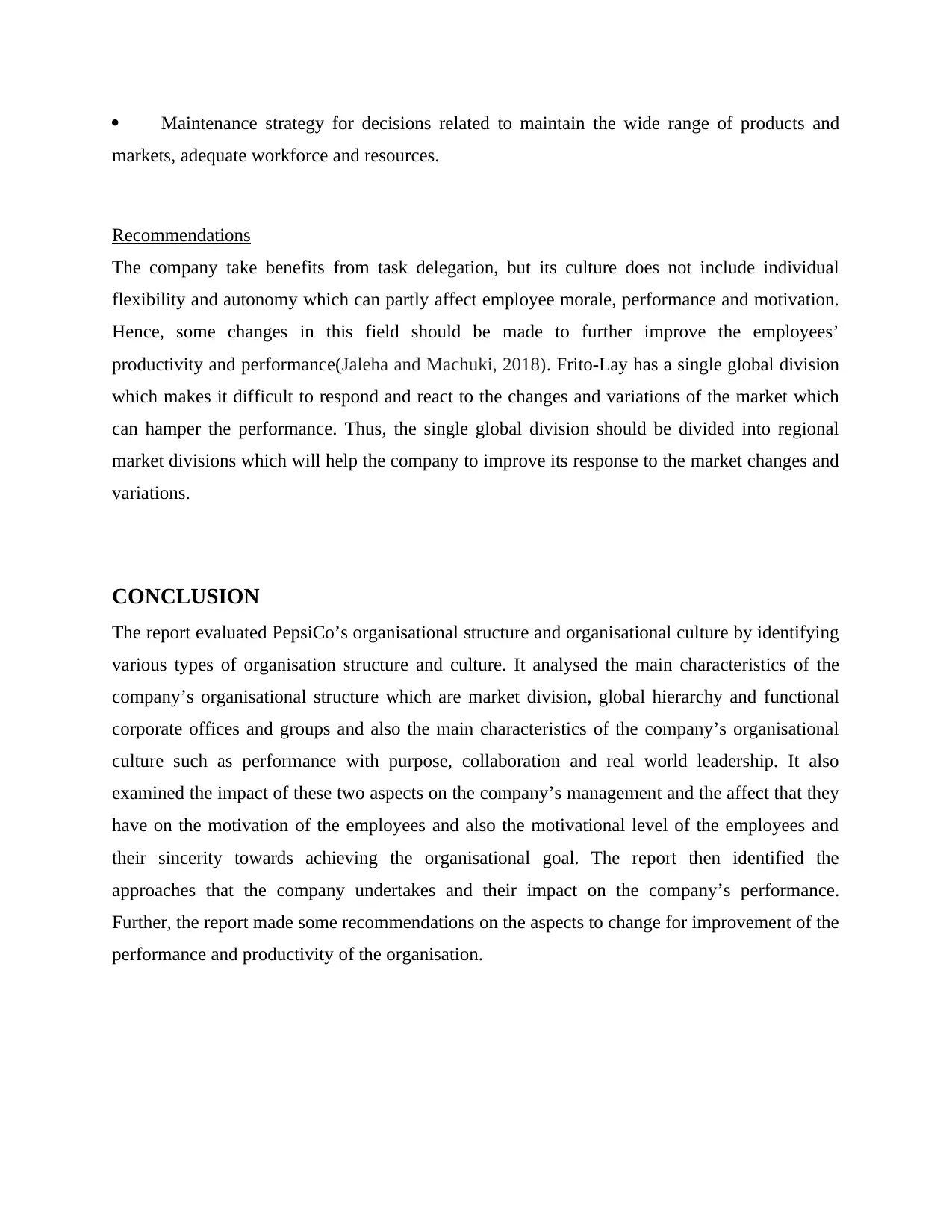
Maintenance strategy for decisions related to maintain the wide range of products and
markets, adequate workforce and resources.
Recommendations
The company take benefits from task delegation, but its culture does not include individual
flexibility and autonomy which can partly affect employee morale, performance and motivation.
Hence, some changes in this field should be made to further improve the employees’
productivity and performance(Jaleha and Machuki, 2018). Frito-Lay has a single global division
which makes it difficult to respond and react to the changes and variations of the market which
can hamper the performance. Thus, the single global division should be divided into regional
market divisions which will help the company to improve its response to the market changes and
variations.
CONCLUSION
The report evaluated PepsiCo’s organisational structure and organisational culture by identifying
various types of organisation structure and culture. It analysed the main characteristics of the
company’s organisational structure which are market division, global hierarchy and functional
corporate offices and groups and also the main characteristics of the company’s organisational
culture such as performance with purpose, collaboration and real world leadership. It also
examined the impact of these two aspects on the company’s management and the affect that they
have on the motivation of the employees and also the motivational level of the employees and
their sincerity towards achieving the organisational goal. The report then identified the
approaches that the company undertakes and their impact on the company’s performance.
Further, the report made some recommendations on the aspects to change for improvement of the
performance and productivity of the organisation.
markets, adequate workforce and resources.
Recommendations
The company take benefits from task delegation, but its culture does not include individual
flexibility and autonomy which can partly affect employee morale, performance and motivation.
Hence, some changes in this field should be made to further improve the employees’
productivity and performance(Jaleha and Machuki, 2018). Frito-Lay has a single global division
which makes it difficult to respond and react to the changes and variations of the market which
can hamper the performance. Thus, the single global division should be divided into regional
market divisions which will help the company to improve its response to the market changes and
variations.
CONCLUSION
The report evaluated PepsiCo’s organisational structure and organisational culture by identifying
various types of organisation structure and culture. It analysed the main characteristics of the
company’s organisational structure which are market division, global hierarchy and functional
corporate offices and groups and also the main characteristics of the company’s organisational
culture such as performance with purpose, collaboration and real world leadership. It also
examined the impact of these two aspects on the company’s management and the affect that they
have on the motivation of the employees and also the motivational level of the employees and
their sincerity towards achieving the organisational goal. The report then identified the
approaches that the company undertakes and their impact on the company’s performance.
Further, the report made some recommendations on the aspects to change for improvement of the
performance and productivity of the organisation.
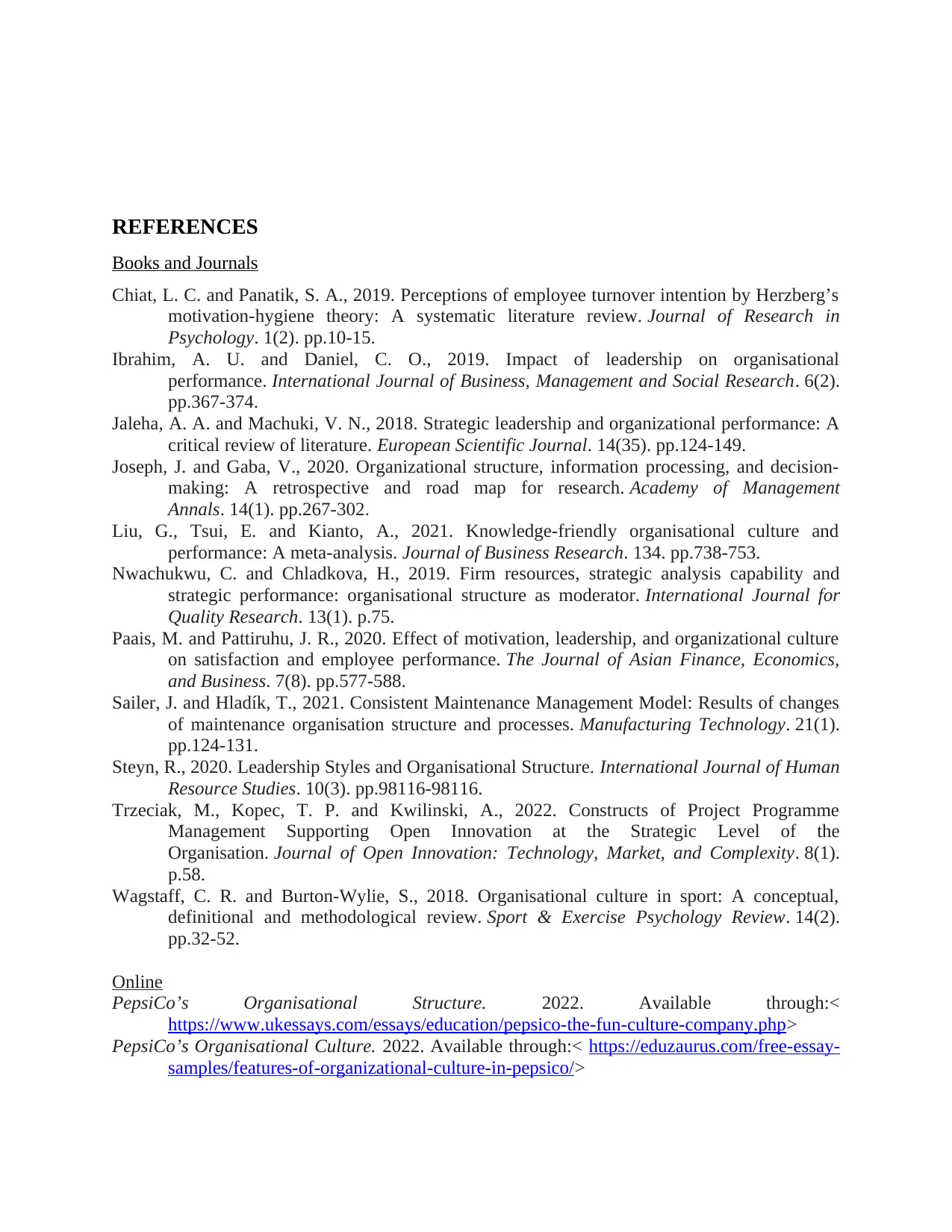
REFERENCES
Books and Journals
Chiat, L. C. and Panatik, S. A., 2019. Perceptions of employee turnover intention by Herzberg’s
motivation-hygiene theory: A systematic literature review. Journal of Research in
Psychology. 1(2). pp.10-15.
Ibrahim, A. U. and Daniel, C. O., 2019. Impact of leadership on organisational
performance. International Journal of Business, Management and Social Research. 6(2).
pp.367-374.
Jaleha, A. A. and Machuki, V. N., 2018. Strategic leadership and organizational performance: A
critical review of literature. European Scientific Journal. 14(35). pp.124-149.
Joseph, J. and Gaba, V., 2020. Organizational structure, information processing, and decision-
making: A retrospective and road map for research. Academy of Management
Annals. 14(1). pp.267-302.
Liu, G., Tsui, E. and Kianto, A., 2021. Knowledge-friendly organisational culture and
performance: A meta-analysis. Journal of Business Research. 134. pp.738-753.
Nwachukwu, C. and Chladkova, H., 2019. Firm resources, strategic analysis capability and
strategic performance: organisational structure as moderator. International Journal for
Quality Research. 13(1). p.75.
Paais, M. and Pattiruhu, J. R., 2020. Effect of motivation, leadership, and organizational culture
on satisfaction and employee performance. The Journal of Asian Finance, Economics,
and Business. 7(8). pp.577-588.
Sailer, J. and Hladík, T., 2021. Consistent Maintenance Management Model: Results of changes
of maintenance organisation structure and processes. Manufacturing Technology. 21(1).
pp.124-131.
Steyn, R., 2020. Leadership Styles and Organisational Structure. International Journal of Human
Resource Studies. 10(3). pp.98116-98116.
Trzeciak, M., Kopec, T. P. and Kwilinski, A., 2022. Constructs of Project Programme
Management Supporting Open Innovation at the Strategic Level of the
Organisation. Journal of Open Innovation: Technology, Market, and Complexity. 8(1).
p.58.
Wagstaff, C. R. and Burton-Wylie, S., 2018. Organisational culture in sport: A conceptual,
definitional and methodological review. Sport & Exercise Psychology Review. 14(2).
pp.32-52.
Online
PepsiCo’s Organisational Structure. 2022. Available through:<
https://www.ukessays.com/essays/education/pepsico-the-fun-culture-company.php>
PepsiCo’s Organisational Culture. 2022. Available through:< https://eduzaurus.com/free-essay-
samples/features-of-organizational-culture-in-pepsico/>
Books and Journals
Chiat, L. C. and Panatik, S. A., 2019. Perceptions of employee turnover intention by Herzberg’s
motivation-hygiene theory: A systematic literature review. Journal of Research in
Psychology. 1(2). pp.10-15.
Ibrahim, A. U. and Daniel, C. O., 2019. Impact of leadership on organisational
performance. International Journal of Business, Management and Social Research. 6(2).
pp.367-374.
Jaleha, A. A. and Machuki, V. N., 2018. Strategic leadership and organizational performance: A
critical review of literature. European Scientific Journal. 14(35). pp.124-149.
Joseph, J. and Gaba, V., 2020. Organizational structure, information processing, and decision-
making: A retrospective and road map for research. Academy of Management
Annals. 14(1). pp.267-302.
Liu, G., Tsui, E. and Kianto, A., 2021. Knowledge-friendly organisational culture and
performance: A meta-analysis. Journal of Business Research. 134. pp.738-753.
Nwachukwu, C. and Chladkova, H., 2019. Firm resources, strategic analysis capability and
strategic performance: organisational structure as moderator. International Journal for
Quality Research. 13(1). p.75.
Paais, M. and Pattiruhu, J. R., 2020. Effect of motivation, leadership, and organizational culture
on satisfaction and employee performance. The Journal of Asian Finance, Economics,
and Business. 7(8). pp.577-588.
Sailer, J. and Hladík, T., 2021. Consistent Maintenance Management Model: Results of changes
of maintenance organisation structure and processes. Manufacturing Technology. 21(1).
pp.124-131.
Steyn, R., 2020. Leadership Styles and Organisational Structure. International Journal of Human
Resource Studies. 10(3). pp.98116-98116.
Trzeciak, M., Kopec, T. P. and Kwilinski, A., 2022. Constructs of Project Programme
Management Supporting Open Innovation at the Strategic Level of the
Organisation. Journal of Open Innovation: Technology, Market, and Complexity. 8(1).
p.58.
Wagstaff, C. R. and Burton-Wylie, S., 2018. Organisational culture in sport: A conceptual,
definitional and methodological review. Sport & Exercise Psychology Review. 14(2).
pp.32-52.
Online
PepsiCo’s Organisational Structure. 2022. Available through:<
https://www.ukessays.com/essays/education/pepsico-the-fun-culture-company.php>
PepsiCo’s Organisational Culture. 2022. Available through:< https://eduzaurus.com/free-essay-
samples/features-of-organizational-culture-in-pepsico/>
⊘ This is a preview!⊘
Do you want full access?
Subscribe today to unlock all pages.

Trusted by 1+ million students worldwide
1 out of 13
Related Documents
Your All-in-One AI-Powered Toolkit for Academic Success.
+13062052269
info@desklib.com
Available 24*7 on WhatsApp / Email
![[object Object]](/_next/static/media/star-bottom.7253800d.svg)
Unlock your academic potential
Copyright © 2020–2025 A2Z Services. All Rights Reserved. Developed and managed by ZUCOL.


